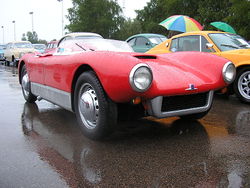Difference between revisions of "MF layout"
m |
|||
| (4 intermediate revisions by the same user not shown) | |||
| Line 1: | Line 1: | ||
| − | + | {{X}} | |
| − | |||
| − | |||
| − | + | [[Image:Sonett-mk1-red.jpg|thumb|250px|[[Saab Sonett]] mk1 used the MF layout by turning the engine and running it "backwards".]] | |
| − | + | In [[automotive design]], a '''MF''', or '''[[mid-engine design|Mid-engine]], [[Front-wheel drive]] layout''' is one in which the front roadwheels are driven by an [[internal-combustion engine]] placed just behind them, in front of the passenger compartment. In contrast to the [[Front-engine, front-wheel drive layout]] (FF), the [[center of mass]] of the engine is behind the front axle. This layout is typically chosen for its better weight distribution (the heaviest component is near the center of the car, lowering its [[moment of inertia]]). | |
| − | + | ||
| − | + | However, the mid-engined layout does use up central space, making the resulting vehicle rather long. This may be why no manufacturer currently offers the MF layout. | |
| − | + | ||
| − | + | Examples of road cars using the MF layout include the [[Cord Automobile|Cord 810]], [[Citroën Traction Avant]], [[Citroën DS]], [[Renault 4]], [[Saab Sonett]] mk1, and the [[Citroën SM]]. This layout was adopted by Renault from the 1960s until the end of the 1980s. The format was revived briefly with the first and second generation [[Honda Vigor]] - [[Honda Inspire]] from 1989-1998, and the [[Honda Rafaga]] from 1993-1997. These vehicles have [[Longitudinal engine|longitudinal]] mounted engines; [[transverse]] engined vehicles are possible in theory if the issue of passenger footwell location is addressed. | |
| − | + | ||
| − | + | Traditionally, the term ''mid-engine'' has been reserved for cars that place the engine and [[transaxle]] behind the driver and in front of the rear axles {{Fact|date=March 2009}}, as in the [[Lamborghini Countach]] or [[Ferrari Testarossa]], but an engine placed in front of the driver's compartment but fully behind the front axle line also qualifies as ''mid-engine''. | |
| − | + | ||
| − | + | ||
| − | + | {{Automobile layouts}} | |
| + | |||
| + | |||
| + | {{Automobile configurations}} | ||
[[Category:Automobile layouts]] | [[Category:Automobile layouts]] | ||
Latest revision as of 08:04, 22 November 2009

In automotive design, a MF, or Mid-engine, Front-wheel drive layout is one in which the front roadwheels are driven by an internal-combustion engine placed just behind them, in front of the passenger compartment. In contrast to the Front-engine, front-wheel drive layout (FF), the center of mass of the engine is behind the front axle. This layout is typically chosen for its better weight distribution (the heaviest component is near the center of the car, lowering its moment of inertia).
However, the mid-engined layout does use up central space, making the resulting vehicle rather long. This may be why no manufacturer currently offers the MF layout.
Examples of road cars using the MF layout include the Cord 810, Citroën Traction Avant, Citroën DS, Renault 4, Saab Sonett mk1, and the Citroën SM. This layout was adopted by Renault from the 1960s until the end of the 1980s. The format was revived briefly with the first and second generation Honda Vigor - Honda Inspire from 1989-1998, and the Honda Rafaga from 1993-1997. These vehicles have longitudinal mounted engines; transverse engined vehicles are possible in theory if the issue of passenger footwell location is addressed.
Traditionally, the term mid-engine has been reserved for cars that place the engine and transaxle behind the driver and in front of the rear axles Template:Fact, as in the Lamborghini Countach or Ferrari Testarossa, but an engine placed in front of the driver's compartment but fully behind the front axle line also qualifies as mid-engine.
| Automobile layouts |
|---|
| Layouts: |
| FF | FMR | FR | MF | RMR | RR | F4 |
| Engine positioning: |
| Front-engine | Mid-engine | Rear-engine |
| Drive: |
| Front-wheel drive | Rear-wheel drive | Four-wheel drive | Six-wheel drive |